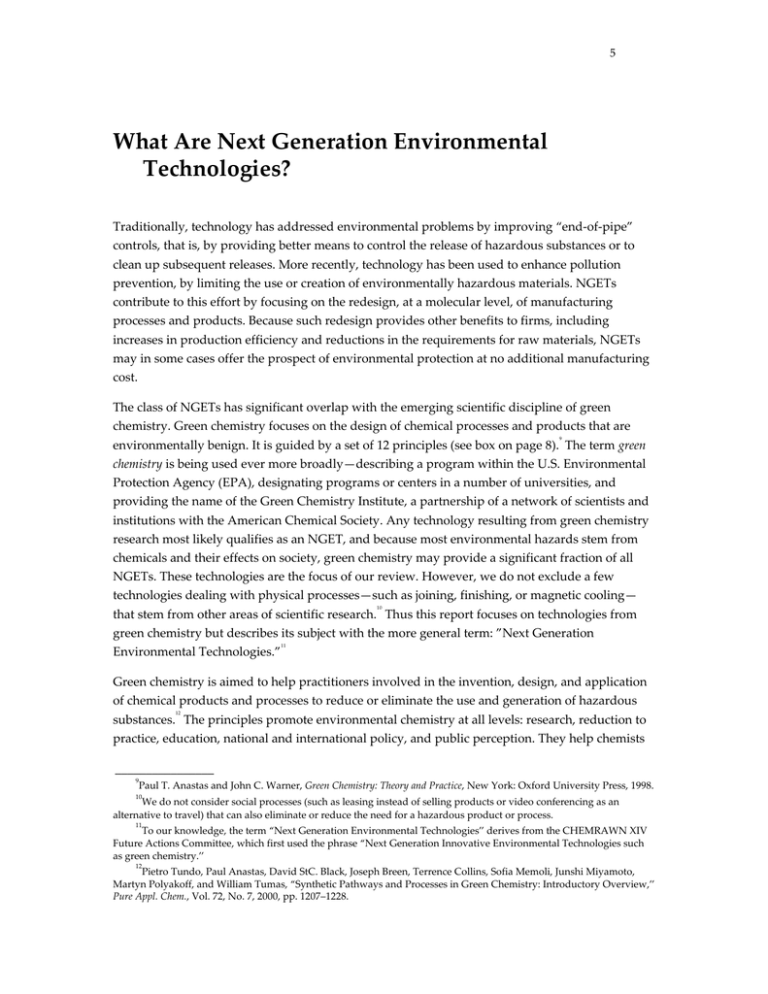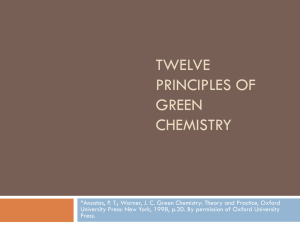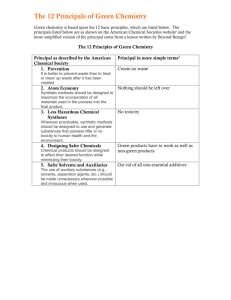What Are Next Generation Environmental Technologies?
advertisement

5 What Are Next Generation Environmental Technologies? Traditionally, technology has addressed environmental problems by improving “end-of-pipe” controls, that is, by providing better means to control the release of hazardous substances or to clean up subsequent releases. More recently, technology has been used to enhance pollution prevention, by limiting the use or creation of environmentally hazardous materials. NGETs contribute to this effort by focusing on the redesign, at a molecular level, of manufacturing processes and products. Because such redesign provides other benefits to firms, including increases in production efficiency and reductions in the requirements for raw materials, NGETs may in some cases offer the prospect of environmental protection at no additional manufacturing cost. The class of NGETs has significant overlap with the emerging scientific discipline of green chemistry. Green chemistry focuses on the design of chemical processes and products that are 9 environmentally benign. It is guided by a set of 12 principles (see box on page 8). The term green chemistry is being used ever more broadly—describing a program within the U.S. Environmental Protection Agency (EPA), designating programs or centers in a number of universities, and providing the name of the Green Chemistry Institute, a partnership of a network of scientists and institutions with the American Chemical Society. Any technology resulting from green chemistry research most likely qualifies as an NGET, and because most environmental hazards stem from chemicals and their effects on society, green chemistry may provide a significant fraction of all NGETs. These technologies are the focus of our review. However, we do not exclude a few technologies dealing with physical processes—such as joining, finishing, or magnetic cooling— 10 that stem from other areas of scientific research. Thus this report focuses on technologies from green chemistry but describes its subject with the more general term: ”Next Generation 11 Environmental Technologies.” Green chemistry is aimed to help practitioners involved in the invention, design, and application of chemical products and processes to reduce or eliminate the use and generation of hazardous 12 substances. The principles promote environmental chemistry at all levels: research, reduction to practice, education, national and international policy, and public perception. They help chemists ________________ 9 Paul T. Anastas and John C. Warner, Green Chemistry: Theory and Practice, New York: Oxford University Press, 1998. 10 We do not consider social processes (such as leasing instead of selling products or video conferencing as an alternative to travel) that can also eliminate or reduce the need for a hazardous product or process. 11 To our knowledge, the term “Next Generation Environmental Technologies” derives from the CHEMRAWN XIV Future Actions Committee, which first used the phrase “Next Generation Innovative Environmental Technologies such as green chemistry.” 12 Pietro Tundo, Paul Anastas, David StC. Black, Joseph Breen, Terrence Collins, Sofia Memoli, Junshi Miyamoto, Martyn Polyakoff, and William Tumas, “Synthetic Pathways and Processes in Green Chemistry: Introductory Overview,” Pure Appl. Chem., Vol. 72, No. 7, 2000, pp. 1207–1228. 6 and chemical engineers design more environmentally benign products and processes through the selection of feedstocks, reagents, alternative synthetic transformations, solvents, reaction conditions, and end products, as well as the design of safer chemicals. For instance, when considering what feedstocks to use in generating a particular compound, the green chemist will explore renewable feedstocks whenever practical. There is no guarantee that such renewable feedstocks are possible for a given reaction nor, if they are, that they will provide a net environmental benefit. Nonetheless, the principles of green chemistry provide a set of design criteria and goals that can help improve the environmental performance of new products and processes. As they begin to apply the principles of green chemistry, chemists are discovering many pathways toward environmentally greener designs. For instance, synthetic catalysts and biocatalysts such as enzymes offer a variety of alternative synthetic pathways that are consistent with the principles of green chemistry. These catalysts also enable the use of alternative reagents and feedstocks, previously impractical with conventional chemistries. The two crosscutting enabling technologies hold much promise in fulfilling the expectations for green chemistry. In surveying the field, it is useful to employ a taxonomy of methods that develop NGETs. To that end, we use the seven areas of green chemistry, a taxonomy that has been laid out to help describe green chemistry research: 13 A. Use of alternative feedstocks that are both renewable and less toxic to human health and to the environment. B. Use of innocuous reagents that are inherently less hazardous and are catalytic. C. Employment of natural processes—biosynthesis, biocatalysis, and biotech-based chemical transformations for both efficiency and selectivity. D. Use of alternative solvents that reduce potential harm to the environment and serve as alternatives to currently used volatile organic solvents, chlorinated solvents, and other hazardous chemicals. E. Safer chemical design—with principles of toxicology to minimize intrinsic hazards while maintaining needed functionality. F. Development of alternative reaction conditions that increase selectivity and enable easier separations. G. Minimization of energy consumption. ________________ 13 Tundo et al., “Synthetic Pathways and Processes in Green Chemistry,” 2000. Posters from the American Chemical Society (www.chemistry.org/education/greenchem) highlight six themes: (1) Use renewable resources; place greater emphasis on renewable starting materials. (2) Find safer solvents; eliminate the use of toxic solvents to dissolve the reacting materials. (3) Economize on atoms; design reactions in which most or all of the atoms end up in the desired product rather than in the waste product. (4) Get off to a good start; identify reactions that use nonhazardous materials to make the desired product. (5) Return safe substances to the environment; produce products that are benign or rapidly biodegradable. (6) Lower energy input; use methods that minimize the energy required for a reaction to take place. 7 All the case studies considered in this report employ one or more of these methods. More information on how these methods are employed in each case study is covered in Table 1 and Appendix A. Assessing the Promise of NGETs NGET proponents foresee a promising future based on an increasing awareness of green chemistry and growth in commercial applications over the next two decades. The authors of the chemical industry’s Vision 2020 are typical in their optimism: While the challenges of sustainability are significant, there are also major opportunities. . . . The chemical industry now has the opportunity to accelerate its development of advanced manufacturing technologies and new chemistry and related technologies that use materials and energy more efficiently. U.S. companies also have an opportunity to build on their current dominance in the relatively new field of environmental technology. Environmental technologies make sustainable development possible by reducing risk, improving process efficiency, and creating products and processes that are environmentally beneficial or benign. 14 To support this vision, the chemical industry has established goals of reducing feedstock losses to waste and by-products by 90 percent, energy intensity by 30 percent, and emissions and effluents by 30 percent, all by the year 2020. This report provides a first step toward assessing the potential of NGETs to help meet such goals identified by the chemical and many other industries. We examined 25 existing NGETs in this process. The technologies considered span the range of development from early research to full deployment in profitable businesses. Those that have been commercialized are offering significant benefits. Others that are still in various developmental stages offer similar promise. In addition to supporting more public and private sector research, policymakers will be considering appropriate mechanisms to express society’s demand for the benefits that NGETs can offer. Even when NGETs can provide such benefits at little or no cost, they must compete inside firms with other investment opportunities. Furthermore, the diversity of potential NGET applications offers both a benefit and a challenge. Policymakers are unlikely to know beforehand the full range of future benefits that are possible. Thus for NGETs to play their full role in a new approach to environmental protection, policymakers will need to determine society’s demand for such benefits, the best ways to achieve them, and the rationale for actions to be taken, communicating these to industry and society at large. ________________ 14 The Vision 2020 study, completed in 1996, was in part stimulated by a request from the White House Office of Science and Technology Policy for industry advice on how the U.S. government could better allocate R&D funding to advance the manufacturing base of the U.S. economy. See http://www.ccrhq.org/vision/. Vision 2020 did not use the term “green chemistry,” but follow-up efforts did. 8 15 Twelve Principles of Green Chemistry 1. 2. It is better to prevent waste than to treat or clean up waste after it is formed. Synthetic methods should be designed to maximize the incorporation of all materials used in the process into the final product. 3. Wherever practicable, synthetic methodologies should be designed to use and generate substances that possess little or no toxicity to human health and the environment. 4. Chemical products should be designed to preserve efficiency of function while reducing toxicity. 5. The use of auxiliary substances (e.g., solvents, separation agents) should be made unnecessary wherever possible and innocuous when used. 6. Energy requirements should be recognized for their environmental and economic impacts and should be minimized. Synthetic methods should be conducted at ambient temperature and pressure. 7. A raw material of feedstock should be renewable rather depleting wherever technically and economically practicable. 8. Unnecessary derivitization (blocking group, protection/deprotection, temporary modification of physical/chemical processes) should be avoided whenever possible. 9. Catalytic reagents (as selective as possible) are superior to stoichiometric reagents. 10. Chemical products should be designed so that at the end of their function they do not persist in the environment and break down into innocuous degradation products. 11. Analytical methodologies need to be further developed to allow for real-time, in-process monitoring and control prior to the formation of hazardous substances. 12. Substances and the form of a substance used in a chemical process should be chosen so as to minimize the potential for chemical accidents, including releases, explosions, and fires. ________________ 15 Anastas and Warner, Green Chemistry, 1998.



